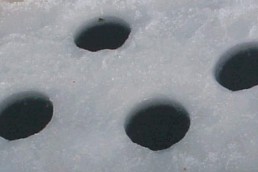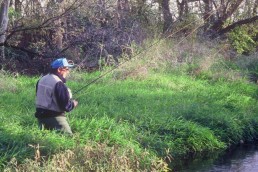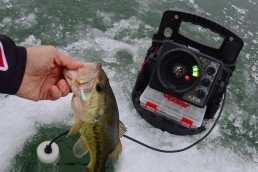Drill More Holes
SHARE THIS POST
Prior to writing this article, I was at the Plano Molding Outlet store and they had all the ice fishing equipment out on display: ice rods and reels, tip-ups, ice shelters, skimmers, you name it, it was there. It felt as if first ice was just a mere few days away. Temps were hovering in the mid-70s with a thunderstorm nearby as I exited the store. Reality quickly set in and the urge to get home and check the blades on the ice auger dissipated with each slap of the windshield wiper blades.
But the visit and that “new shelter smell” got the old wheels turning thinking about the upcoming ice season. When I see the equipment today from tackle to clothing to shelters, and of course, the electronics, I am truly amazed at the advancements made in ice gear that help aid in the pursuit of that which swims under the canopy of frozen water.
I think back years ago when I bought my first Vexilar locator along with the “new” Dave Gentz bright blue Ice Box that helped carry your locator and the battery. Man, I thought, I was cutting edge, a regular local ice fishing “legend”—only in my mind of course. Ice anglers would stop by and want to check out the multi-colored flasher, hoping to see that red mark rise up toward their bait.
Today, electronics are commonplace on the ice with a variety of brands and types of under ice viewing devices from flashers to cameras. With each coming season—as with all electronics—I suspect advances will forever continue.
But I did fish many an ice season without the luxury of today’s new electronics. My depth finder consisted of an orange- painted lead with an alligator clip on top, which clipped to your lure or hook and was simply lowered through the ice to establish the depth. Quite the primitive piece of angling equipment, but for us back then it did serve its purpose to get you your depth. It lacked a little in its side imaging capabilities, but that’s what we had.
Last season I received a late email just before ice-out from a rather new ice angler who found himself quite discouraged with all the advanced equipment—not that he didn’t approve of the new technologies in the sport, but that he just lacked the financial resources of dropping several hundred dollars on “must have” electronics. He could budget for the basics: a couple of rods and reels, some tackle, an auger, and, of course, a bucket. But financial obligations kept him from more equipment.
“Should I even bother with such basic gear?” he asked.
My reply to him was an overwhelming—“Yes!”
I sent him a few suggestions and he got back to me in a few days about the great time he was having on the ice, “electronics- free.”
Years ago I had the honor and blessing to fish with an incredible ice fishing master, Chuck Thompson. Back then Chuck was not only a well-known ice angler in the Chicagoland area, but was captain of the U.S. Ice Fishing Team. I only fished a few sessions on the ice with Chuck, but to be honest, I learned more in those outings about ice fishing than I could have in years of trial and error on my own.
While the Vexilar ice flasher was soon to make its debut on the ice fishing scene—and become not only a regular fixture on my ice fishing outings as it would be, but in Chuck’s also—I remember sitting just a few feet away from Chuck on the ol’ “5-gallon bucket seat.” Chuck tolerated my machine fire questions about ice fishing in a gracious manner as I felt the need to draw as much information as I could on these outings.
Finally, near the end of one of our days fishing, I asked one of those questions that you know might keep that person talking for quite some time to give you a complete answer:
“Chuck, what is the best advice you can give me that will up my success rate in the future when I spend time on the ice?”
Chuck replied, “I’ll tell you…”
I waited patiently as he quietly unhooked yet another monster bluegill. As I watched him work the jig out of the ‘gill’s mouth, I started to think, Do I need a pen and paper, a recording device maybe? How was I going to capture this jewel he was about to hurl at me?
Never taking his eyes off the portal to the underwater world below, he said, “…Drill more holes,” as he slowly lowered his bait down into the depths.
“And…?” I asked?
Are you enjoying this post?
You can be among the first to get the latest info on where to go, what to use and how to use it!
“Nope…that’s about it.”
I sat perched on the edge of my bucket for that?
“But Chuck, what about techniques, rigs, floats, jigs, bait colors, line diameters, etc.?”
“Aw, you’ll figure that out—what works best for you, just drill more holes.”
“So where: shallows, deep, on the weedlines, around wood, drop-offs?” I asked.
“Um, yep, all those spots you just mentioned, that would be good”, Chuck replied, his eyes never leaving his hole.
And you know what, in all its simplicity, Chuck’s answer was the best ice fishing advice I ever received.
I began turning the frozen waters I fished into Swiss cheese, covering the lakes and ponds from the shallows to the depths, inside and outside edges of weedlines, wood and timber in the water. The reward for following Chuck’s advice were buckets of panfish, bass and pike from rod and reel and tip-up presentations, all success achieved electronics-free and with nothing more to check my depths than my orange lead.
So to those of you who think ice fishing has advanced beyond your technical abilities or beyond your household budget, think again.
Let’s hit a few basic techniques and suggestions to get you out on the ice and catching fish:
First, try to find a lake or pond with some varying depths to it, maybe a little brush or wood in the water, and some decent weedlines. If there are no lake maps for you to check the depths, you might just have to do some searching with the auger. In this area of the Midwest, I like to find bodies of water with some depths up to approximately 12 to 20 feet somewhere in the lake.
I have a sketch on where I would do my hole search, but briefly, I start by drilling holes from the shallows out to the deepest water in the lake or pond, checking my depths with my lead at each hole. If you have any kind of structure such as brush, wood, or weedlines, circle the structure fishing both the shallow and deep sides. I will often drill as many as 30 holes in my area all at once, then begin my search of each hole with rod and reel.
Now one important tip to keep in mind: I work each hole slowly from the shallows to the depths. Fish can be anywhere from just inches under the ice to laying a few inches off bottom. Once a certain depth seems to be creating a pattern, I’ll work that depth from hole to hole, but I never stop experimenting, as fish will change depths and locations throughout the day.
The secret is to keep moving to locate active fish. With all my holes drilled, I won’t spend more than 5 or 10 minutes working a hole without a bite before moving to the next. With all this moving, you have probably figured I’m not pulling a shelter over each hole and you would be right. Nothing wrong with setting up a shelter in an active area, but I have a tendency to move more than a shelter will allow. Even with my electronics today, I rarely pop up the shelter. That’s just my choice. If you have a shelter and prefer to use it, by all means pop it up.
I know this article lacked the newest and best secrets for the 2015-16 ice season, but my intent was to convince you to get out and give ice fishing a try. And if you have a limited budget for your ice fishing, that’s fine, you can still get out this winter and have some memorable times exploring parts of your favorite body of water you may never be able to reach during the open-water season.
One last reminder: Be safe out there and make sure you have plenty of ice thickness before venturing out. Let me know how you are doing out there and if I can be of further assistance.
You can e-mail Dan Brozowski at onthebank@att.net.
MWO
SHARE THIS POST
Did you enjoy this post?
You can be among the first to get the latest info on where to go, what to use and how to use it!
Dan Brozowski
Passion for angling drives Dan Brozowski to the water’s edge virtually any chance he gets. Although passion cannot be measured, weighed, or recorded, it can be shared. He does this through his writing and while on the water. If you have any questions or comments for Dan, you may contact him at: onthebank@att.net.



